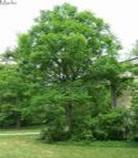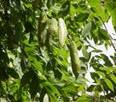| Kingdom | Plantae |
| Division | Magnoliophyta |
| Class | Magnoliopsida |
| Order | Fabales |
| Family | Fabaceae |
| Genus | Gymnocladus |
| Species | G. dioicus |
| Binomial name | Gymnocladus dioicus |
Other Common Names:
The other common names for the Kentucky coffee tree are coffeetree, nicor tree and chicot.
History

Description
The Kentucky coffee tree is a short-trunked tree with narrow, open crown of coarse branches and very large, twice-compound leaves. When crowded by other trees, this species grows tall and slender. If more open-grown, it becomes a round-topped tree. Its unique bark is dark brown and roughened with scale-like ridges in distinct patterns. It leafs out late in spring. The large, twice-compound leaves give the foliage a tropical look. Greenish-white flowers are held in terminal clusters, and the fruit is a purplish-brown pod that remains into winter.


Range
The Kentucky coffee tree is a native to bottomlands of the Eastern, Midwestern, and Central United States. It grows in bottomlands, ravines, and lower slopes of the Appalachian Mountains from western New York and western Pennsylvania, west to southern Wisconsin, and south through Kentucky, Tennessee, Arkansas, eastern Oklahoma and northern Louisiana.
Habitat
The Kentucky coffee trees thrives best in full sun to partial sun and generally prefers continuously moist, rich, deep soils in full sun, but is very adaptable and urban tolerant, especially to heat, drought, very alkaline pH soils, soil compaction, and wet sites. Kentucky coffee tree does best in a well drained, rich soil with adequate moisture. However, it can tolerate normal droughts.
Cultivation
Fertilize with formulations that promote woody, strong growth rather than excessive foliar growth. Seed are best sown in a greenhouse as soon as it is ripe. The seed can also be sown in early spring in a greenhouse. Scarification and pre-soaking the seed for 24 hours in warm water, especially if it has been stored, will improve germination. Make sure the seed has swollen after soaking, soak it again if it has not and, if it still does not swell, try filing away some of the seed coat but be careful not to damage the embryo. As soon as they are large enough to handle, prick the seedlings out into fairly deep individual pots and grow them on in the greenhouse for at least their first winter. Plant them out into their permanent positions in late spring or early summer, after the last expected frosts. Consider giving them some protection against the cold for their first couple of winter's outdoors Root cuttings 4cm long and 1cm thick in a greenhouse in December. Plant the roots horizontally in pots. Longer, weaker branches should be pruned when young to promote a stronger structure.
Flowering Season
The dioecious male and female flowers are in long branched clusters and are whitish in colour appearing in late spring.
Pests and Diseases
No pests or diseases are of major concern.
Parts Used



The root, bark, leaves and the seeds are mostly used parts of the tree for its commercial and medicinal applications.
Medicinal Applications

• Infusions of the roots and bark were used by Native Americans as a laxative.
• The pulverised root bark is used as an effective enema.
• A snuff made from the pulverized root bark has been used to cause sneezing in comatose patients.
• It is used in the treatment of coughs due to inflamed mucous membranes.
• Kentucky coffee tree also aids in speedening up of a protracted labour.
• It is also used in homeopathic medicine.
Commercial Applications


• The roasted seeds were once used as a coffee substitute.
• The reddish-brown wood makes attractive cabinets, and the fruit pulp has been used in home remedies.
• The fruit contains hich content of saponins and is used in the soap industry.
• Kentucky coffee tree is useful as an urban tree and for street plantings.
• The dark, round shiny seeds also have some aesthetic appeal as beads in rustic jewellery.
• The leaves are also used to poison the flies.
• It is used in cabinet making and fencing.
• The seedpod can be eaten raw or cooked.

The common name "coffee tree" derives from the use of the roasted seeds as a substitute for coffee in times of poverty. Kentucky coffee tree, also nicker tree or chicot, common name for a tall North American tree and the folklores says that the seeds were roasted and used as a coffee substitute during the American Civil War. Myths say that the Kentucky coffee tree is a toxic plant to the cats. It is believed that it has got the name Gymnocladus which means" naked branch", and refers to the clumsy branches that have no leaves most of the year. There are folktales and myths saying that it was known as "hully-gullies" and are sometimes carried by children as a good luck charm. Used as a street tree in some communities.